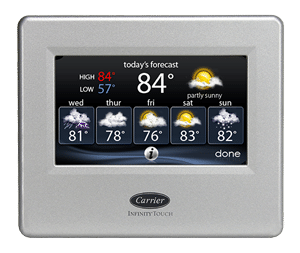Just as every household runs on a different time schedule, each room in your home has its own heating and cooling requirements as well. Ensuring that the rooms everyone uses throughout the day are comfortable can be as challenging as trying to keep track of all of your family’s comings and goings. Luckily, you don’t need to possess superhero powers to find an economical solution. When used together, zoning and programmable thermostats are a dynamic duo that can rescue you from sky-high energy bills without sacrificing your home comfort.
Zoned for Home Comfort
Heating and cooling systems equipped with zoning capabilities allow you to alter the temperatures in various rooms in your home according to your household’s unique needs. Instead of conditioning every room at once, you can selectively heat or cool individual spaces for better comfort and lower energy bills. Zoning is the ideal solution for homes with inconsistent room temperatures. It’s perfect for all of those times when you don’t want or need to condition every room in your home too. Here’s how most central HVAC zoning systems work:
- Thermostats in each individual zone are linked to sensors that continually monitor indoor and outdoor temperatures.
- The thermostats are connected to a central control panel that analyzes incoming data and send signals to motorized dampers.
- Air control dampers installed with the HVAC system’s ductwork open or close based on the temperature setting on each individual thermostat to allow just the right amount of air flow into every room.
Optimizing Money and Energy Savings with Programmable Thermostats
Programmable thermostats take the money-saving benefits of a zoned HVAC system to a higher level. These smart devices allow you to preset temperatures according to your schedule, automatically raising or lowering temperatures when no one is using the space. Most models allow you to program temperatures for multiple times of the day for optimal money and energy savings. The set-it-and-forget-it gadgets let everyone enjoy the highest degree of comfort 24/7 without ever having to adjust the thermostat. Here’s an example of a weekday schedule for a family with children:
- 6:30 a.m. Temperatures in bedrooms are automatically adjusted to ensure that the family wakes up to a comfortable environment.
- 7:00 a.m. Other zones are conditioned so the family can be comfortable while getting ready to leave home for the day.
- 8:00 a.m. After the family departs, temperatures in all zones are lowered or raised 15 degrees for the next eight hours, resulting in a 15-percent reduction on heating and cooling bills.
- 4:00 p.m. Living areas are warmed or cooled to ensure that everyone is comfortable as they return home.
- 9:00 p.m. Temperatures in bedrooms are adjusted on cue as the children retire for the night. Living areas like a home office, den or family room are conditioned to allow adults to remain comfortable.
- 11:00 p.m. As adults retire, temperatures in all zones are raised or lowered until the next morning.
Advanced Features and Functions
As the popularity of zoning increases, new HVAC systems are appearing on the market that come equipped with zoning and programmable functions. The best of these advanced systems are designed as whole-home solutions, with optional indoor air quality fixtures that control air filtration, ventilation and humidity levels. All of the devices are controlled by a user-friendly central panel that lets you manage the specific comfort requirements of your home. Some models are Wi-Fi enabled so you can access temperature and indoor air quality controls from your computer or smart devices. Additional features available can include:
- Automatic changeovers between heating and cooling
- Message reminders that let you know when it’s time to change the air filter or schedule preventive maintenance
- Copy features that make it easy to replicate settings for different time periods, days or zones
- Energy usage displays that allow you to monitor energy consumption in real time
- PID controllers that “learn” your ideal temperatures and maintain them
Installation and Cost Considerations
Zoned HVAC systems are commonly installed as energy-efficient building features in new home construction and as energy-saving alternatives when replacing HVAC systems in existing homes. As alterations to ductwork are necessary, the cost of installation can be higher than in conventional central-air systems. When used in combination with programmable thermostats, however, the savings achieved on monthly energy bills can be as high as 40 percent. The zoning system experts at Air Specialty can evaluate your home and give you a complimentary installation estimate to help you determine getting into the zone with this dynamic duo is the right option for you.

